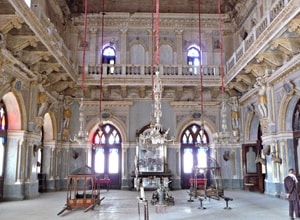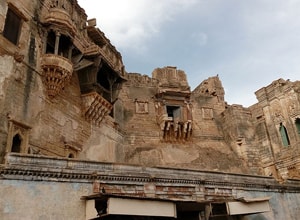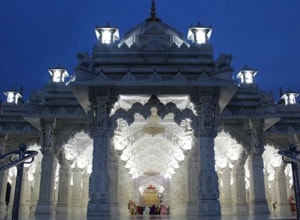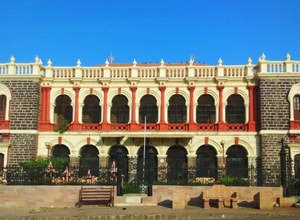





A desert city with long history of kings and empires make Bhuj one of the most interesting and unique historical places to see.
The city has a long history of kings and empires - and hence many historic places to see. The city was left in a state of devastation after the 2001 earthquake and is still in the recovery phase. Bhuj connects you to a range of civilizations and important events in South Asian history through prehistoric archaeological finds, remnants of the Indus Valley Civilization (Harappan), places associated with the Mahabharata and Alexander the Great's march into India and tombs, palaces and other buildings from the rule of the Naga chiefs, the Jadeja Rajputs, the Gujarat Sultans and the British Raj. . The vibrant and dynamic history of the area gives the area a blend of ethnic cultures. In a walk around Bhuj, you can see the Hall of Mirrors at the Aina Mahal; climb the bell tower of the Prag Mahal next door; stroll through the produce market; have a famous Kutchi pau bhaji for lunch; examine the 2000-year-old Kshatrapa inscriptions in the Kutch Museum; admire the sculptures of Ramayana characters at the Ramakund stepwell; walk around Hamirsar Lake and watch children jumping into it from the lake walls as the hot afternoon sun subsides; and catch the sunset among the chhatardis of the Kutchi royal family in a peaceful field outside the center of town.

Prag Mahal is named after Rao Pragmalji II, who commissioned it and construction began in 1865. It was designed by Colonel Henry Saint Wilkins in the Italian Gothic style, and many Italian artisans were involved in its construction. The palace artisans' wages were paid in gold coins. Construction of the palace, which ultimately cost 3.1 million rupees, was completed in 1879 during the regency of Khengarji III (Pragmalji II's son) following Pragmalji II's death in 1875. The local Kutchi builder community (Mistris of Kutch) were also involved in construction of Prag Mahal along with Colonel Wilkins.

Aina Mahal is an 18th-century palace in Bhuj, Gujarat, India. It is located next to the Prag Mahal. It was built by Rao Lakhpatji in 1761. The chief architect and designer of Aina Mahal was Ram Singh Malam,who was assisted by local builder community (Mistris of Kutch) in construction. It was constructed with marble walls adorned with gold lace and glass.The walls of the palace are of white marble covered with mirrors separated by gilded ornaments with shades of Venetian glass. The palace was damaged in the 2001 Gujarat earthquake. However, a portion of the palace which was not so badly damaged has been restored and it houses the museum, displaying the bed room, music room, court room and other old pieces of arts, paintings, arms, palanquin etc.

An earthquake on 26 January 2001 shattered most parts of the city of Bhuj, including the original Shri Swaminarayan Mandir, Bhuj built by Swaminarayan in 1824. To replace this, the new temple is built of only marble and gold. The throne for the idol of Swaminarayan, the temple domes and doors are make of gold while the pillars and ceilings are made of marble.The original central deity images of Nar Narayan and Swaminarayan in the form of Hari Krishna were moved from the old temple to the new one along with those of Radha Krishna, Swaminarayan in the form of Ghanshyam and Sukh Shaiya and others.

Kutch museum was initially formed as a part of the School of Arts established by Khengarji III, the Maharao of Cutch State. It was founded on 1 July 1877. The museum was earlier known as Fergusson Museum. At the time of Maharao Khengarji III's marriage on 19 February 1884 many new items were received and for exhibition of which, a need for new building was necessitated. As such, on 14 November 1884, the foundation stone for the present museum building was laid by the Governor of Bombay, Sir James Fergusson and named Fergusson Museum after him by Maharao of Cutch. The building consisting of two floors cost Rs. 32000 at that time. The museum, constructed in the Italian Gothic style, is located in the picturesque surroundings on the bank of Hamirsar Lake just opposite to the Nazar Bagh Garden. It was designed by the state engineer - Mc Lelland and built by local builders known as Mistris of Kutchunder supervision of state Gaidher - Jairam Ruda Gajdhar. The museum remained the preserve of the Maharao of Cutch, till 1948, who showed it only to his personal guests. In those days museum was opened to the public only on important religious occasions.

Ashapura Mata is one of aspect devi and one of the principle deity of Kutch. As the name indicates, she is the Goddess who fulfills the wish & desires of all those who trust and believe her. The unique thing about most of the idol of Ashapura Mata is that it has 7 pairs of eyes.